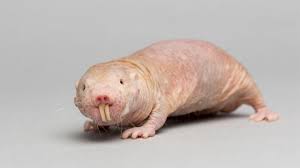Naked mole rat:

A new study of the naked mole rat shows that these animals have evolved a DNA repair mechanism that could explain their longevity.
Key findings of researchers:
- The cyclic GMP-AMP synthase (cGAS) functions differently in naked mole rats compared to humans and mice. (GMP –AMP synthesis which modulates various cellular processes)
- Key differences in cGAS function:
- Humans and Mice: cGAS interferes with DNA repair, increasing the risk of aging and cancer
- Naked Mole Rats: cGAS enhances DNA repair, promoting genome stability and potentially contributing to their longevity.
- This is due to four amino acid substitutions in the cGAS structure that allow it to bind to DNA longer and facilitate repair by bringing together repair proteins FANCI and RAD50.
Naked mole rat:
- It is a small, hairless burrowing rodent native to parts of East Africa.
- It is famous for living an astonishingly long time, up to around 37 years, nearly 10x longer than mammals of similar size.
- It lacks pain sensitivity in its skin and has very low metabolic and respiratory rates.
- It is also remarkable for its longevity and its resistance to cancer and oxygen deprivation.
- Their lifestyle is more akin to that of bees and wasps and other eusocial insects.
- They live in underground burrows that may stretch to 5 km, in colonies of around 70 animals.
- It is cold-blooded, unable to control their body temperature and dependent on the prevailing outside temperature.
- They are predominantly found in southern Ethiopia, Kenya, Somalia, and Djibouti.
- They inhabit drier parts of the tropical grasslands and savanna
- They are herbivores and feed primarily on very large tubers.
- It is eusocial, meaning they live in large colonies in which only one female breeds and the majority of workers (both males and females) spend their entire lives working for the colony.
- Conservation Status: IUCN: Least Concern




